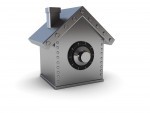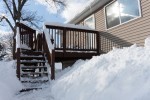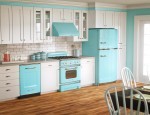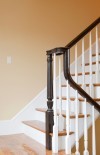 When it comes to the home of our dreams, once we’ve signed the mortgage papers, we want to live there forever. In fact, studies show 89 percent of older Americans prefer to stay living in their homes as long as possible rather than moving to a senior living community. But as we age, things such as stairs, slippery showers, high kitchen counters and even front porch steps can pose problems. One of the challenges of aging is learning how to adapt how we live in our 20s, 30s and 40s to accommodate physical limitations in our 50s, 60s, 70s and beyond.
When it comes to the home of our dreams, once we’ve signed the mortgage papers, we want to live there forever. In fact, studies show 89 percent of older Americans prefer to stay living in their homes as long as possible rather than moving to a senior living community. But as we age, things such as stairs, slippery showers, high kitchen counters and even front porch steps can pose problems. One of the challenges of aging is learning how to adapt how we live in our 20s, 30s and 40s to accommodate physical limitations in our 50s, 60s, 70s and beyond.
Since June is National Safety Month, I thought it was a perfect time to review tips from my book, A Cast of Caregivers, provided by good friend and our favorite certified aging in place specialist (CAPS) expert, Louis Tenenbaum, the founder of the Aging in Place Institute. Aging in place is the term used to describe our desire to stay living in our homes as long and as independently as possible even though we face health challenges and other issues of aging.
Louis took me through a litany of home safety modifications which are actually beneficial for any age. That is what experts call the concept of universal design – to ensure a gadget or home modification works for any age whether you are 18 or 80. One great example of universal design is the OXO Good Grips brand of home kitchen utensils. Originally developed by an engineer for his wife who suffered from arthritis, these gadgets are actually beneficial to anyone at any age.
According to Louis, “There is no one size fits all when it comes to how and where we want to live as we age. However, the reality is that many of these modifications we should be making to our homes now – whatever our age – because they do make the home safer and that is good for everyone.”
The key things to consider when modifying the home are what I call the three S’s:
- Safety from falls. As we age, falling becomes a serious health hazard and for those with certain chronic illnesses, such as multiple sclerosis or Parkinson’s disease, balance can be a challenge that makes falling more possible. According to the Centers for Disease Control, two million seniors are treated in emergency rooms every year for falls at home and falls are the leading cause of injury death among those age 65+. One general tip is to remove any rugs that can easily trip you, especially if you have a cane or wheelchair.
- Stretch and strain reduction. Whether in a wheelchair or just having trouble bending or reaching as we age (weak knees, arthritis) – every day tools for living such as bathroom or kitchen items and things such as clothes need to be within easy reach – with most items stored at waist level.
- Strength changes. As we age our strength levels change. Louis advises that it is typically easier for us to pull than to push as we get older. Therefore, modifications that accommodate this pull rather than push option is another key to making your house your home for a lifetime.
Going room by room with Louis, here are things you need to know to make your loved one’s home and your own home a future dream house:
Entry to the home
- Remove steps and make a gradual grade up to your doorway that is slip-resistant. If there is too much rise for a sloped entry, consider adding a mechanical lift or ramp to achieve a no step entry.
- Ensure the porch or entry to your home has a protective cover so if it israining or snowing you are shielded as you open the door. It may also be easier to make your no step entry to the home at the side or back door or through the garage instead of the front door.
- Add good lighting near the keyhole where many porches have poor lighting. Also, ensure you have good light inside the entry. It is also a good idea to add high contrast or lighted house numbers on the home and the street to make it easier for emergency responders to find your house.
- Create a package shelf near the door – a convenient place to set your handbag or a grocery bag so you can easily find your keys to open the door.
Hallways
- Add On/Off switches at both ends of a hallway, near the top and bottom of stairs, and right outside major rooms leading into a hallway (such as a bedroom). Many homes have switches only at one end of the hallway. Also think about smart or lighted switches which are easier to see at night.
- Change doors – moving doors within a hallway may create the space needed for maneuvering a wheelchair, walker or other device in hallways.
Kitchen
When it comes to the kitchen – the key words are “within easy reach.”
- Lower the counters – most typical kitchen counters are 36 inches high. Lower counters and knee spaces allow you to sit as you chop or mix food (this height level applies to pull out cutting boards as well).
- Additional outlets and switches – these are typically located on the backsplash of counters making them hard to reach. Move these to the ends of counters or just below the counter or inside a lower cabinet for easier access. Also, do not forget to move the switch for the garbage disposal as well.
- Appliances such as ovens should be at lower levels (instead of the higher stacked wall ovens) and have side doors instead of a heavy door which makes it a burn hazard to lean over to get food out. Stoves should have controls on the front of the stove instead of the top or back, again making them hard to reach. Refrigerator doors can be heavy – side-by-side door models are best.
- Store everyday items on middle shelves for easy accessibility. Also invest in sliding shelves for pantries, storage space and even in the refrigerator.
Stairs
- While an elevator may be a little pricey for your budget if your loved one has a multi-story home, an electric stair chair lift may be a reasonable alternative if your loved one has bad knees or a heart condition. Be aware the lifts may drop your loved one on the edge of the top step where falls can happen more easily. Straight run lifts may cost less (typically $2,700 – $3,200). Stairs with bends and curves and landings require custom track (typically $6,000 – $9,000).
- If your loved one doesn’t yet need a lift, ensure there are hand rails on both sides of the stairwell.
- Consider marking (in a fashionable way with designer paint or different wood stains) the rise from the tread so it is easy to see the steps.
- The other option is to move your loved one’s master bedroom and bathroom to the ground floor to avoid the fall risk associated with stairs.
Bathroom
- Remove all towel bars – they are all too fl imsy to hold your weight if you grab for them when falling or off -balance. Instead replace the towel bars with professionally installed grab bars – both for the towels and inside tubs and showers. Add vertical grab bars to help get in and out of the tub as well as horizontal bars. There are really stylish heavy-duty bars from Great Grabz that I like.
- Change the shower to a curbless or no-step shower. Also, add a shower stool if it is easier for your loved one to sit in the shower. Change the showerhead and controls so they can be accessed at waist or sitting level. A handheld model is best.
- A major consideration is having enough room in the bathroom if two people need to be in there at one time. Whether you are helping your loved one or you have a home health aide or personal care assistant that helps with bathing and toileting, you need room for this multi-person activity. Also consider a seat adjuster for the toilet to help easily transfer a loved one who is in a wheelchair.
- One of the most important bathroom modifi cations is to ensure the door swings out not in. If your loved one falls in the bathroom with the door shut, even if help arrives, they may be blocking the door making it harder to get to them.
Garage or Laundry Room
- Front loading washers and dryers are great investments just remember to plan for enough space so they are not stacked on top of each other. Front controls are best as well.
- Remember good lighting for the garage – most garages have low lighting that needs to be improved.
- Ensure you have enough room to get a wheelchair in and out of the car or van. And again, add a ramp so wheelchairs, walkers and canes do not get caught on the bottom lip of a side garage door.
When it comes to modifying your loved one’s home, Louis advised while some of these changes may seem simple, it is wise to contract with a CAPS expert. Many of the details of making these modifications go beyond the skills of your typical handyman and CAPS experts are trained and credentialed on understanding the challenges of aging and can even suggest modifications beyond this list or your initial needs. If your budget cannot accommodate a CAPS expert, there is a non-profit organization, Rebuilding Together that has more than 200,000 volunteers in most communities across the country who can make simple modifications for seniors and people with disabilities.
As Louis told me, “We need to think of our lives and our homes as more of a movie than a snapshot – we want to see the whole picture as we age, not just what our needs are today in freeze frame.”









0 Comments
Trackbacks/Pingbacks